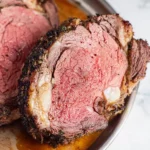Cooking an exceptional no peek prime rib roast isn’t just about technique—it’s about patience, precision, and respect for the beef itself. This oven-off method, often whispered among seasoned chefs, ensures a crisp crust with a juicy, evenly cooked interior without constant checking or fuss. You’ll learn why this prime rib roast recipe has earned the nickname “the oven-closed wonder.” From the initial sear to the silent, heat-retained finish, every step transforms a fine rib cut into an unforgettable dining centerpiece. In this guide, I’ll share the professional secrets behind mastering the no peek prime rib roast—flavor, texture, and timing perfected.
The Story Behind the No Peek Prime Rib Roast
The Origin of the Oven-Off Method
Every chef remembers the first time they tried the no peek prime rib roast. My moment came years ago in a classic steakhouse kitchen, where our head chef swore by this “set it and forget it” approach. The principle was simple: sear the roast at a high temperature, turn the oven off, and never open the door until time says so. The retained heat gently finishes the meat, leaving a uniform pink center without overcooking the exterior. Unlike the traditional prime rib roast recipe bone in on grill or smoker, this oven-closed method relies entirely on physics and patience, not flame.
Why Professional Chefs Love It
The no peek prime rib roast technique minimizes variability—a blessing during service rushes. Because the oven’s residual heat distributes evenly, the risk of overcooking drops dramatically. You can prepare your bone in rib roast with confidence, knowing that it will emerge from the oven medium-rare and succulent. For a chef, that kind of consistency is gold. Whether in a restaurant kitchen or a home oven, this method proves that precision and restraint can outshine complexity.
Print
No Peek Prime Rib Roast
- Total Time: 2 hours 45 minutes
- Yield: 8 servings 1x
Description
No peek prime rib roast (aka the oven-off method) is an easy way to make a perfectly cooked roast beef with a crispy sear and juicy center.
Ingredients
5–8 lb prime rib (boneless or standing rib roast)
5 tbsp prime rib rub (to taste, see recipe)
Instructions
1. Let roast rest at room temperature for 4 hours.
2. Preheat oven to 500°F (260°C).
3. Season roast generously with rub.
4. Roast 5–6 minutes per pound, fat side up.
5. Turn off oven. Do not open for 2 hours.
6. Check internal temp (135–140°F). Adjust if needed.
7. Rest for 10–15 minutes before slicing.
Notes
Use 1 tbsp rub per pound.
If oven fan turns on automatically, disable it.
Reserve drippings for au jus or creamy horseradish sauce.
- Prep Time: 10 minutes
- Cook Time: 2 hours 35 minutes
- Category: Main Course
- Method: Oven-Off Roasting
- Cuisine: American
Nutrition
- Serving Size: 1 slice
- Calories: 853
- Sugar: 0.1g
- Sodium: 127mg
- Fat: 76g
- Saturated Fat: 32g
- Unsaturated Fat: 33g
- Trans Fat: 0g
- Carbohydrates: 2g
- Fiber: 0.3g
- Protein: 39g
- Cholesterol: 171mg
Preparing the Roast Like a Chef
Selecting the Right Cut of Prime Rib
When preparing a prime rib roast recipe, your choice of meat defines your results. Always select USDA Prime or Choice grade beef. A bone in rib roast offers superior flavor due to marrow richness, while boneless versions deliver easier slicing and presentation. Look for deep marbling—those thin white streaks of fat that melt into the roast during cooking. The no peek prime rib roast method works perfectly for both, but thicker cuts (5–8 lbs) benefit most from this slow heat retention.

Professional Prep and Dry Brining
Start by bringing your roast to room temperature for at least four hours (no longer than USDA’s 4-hour guideline). Season liberally using a chef-formulated dry rub: coarse salt, cracked pepper, garlic powder, and a touch of rosemary or thyme. Letting it rest uncovered during this period effectively “dry brines” the beef. This enhances the herb-seasoned prime rib recipe with a darker crust and deeper flavor penetration. Chefs know that the secret to great roasting lies not in constant supervision—but in proper preparation.
Mastering the No Peek Oven Technique
The High-Heat Sear
Preheat your oven to 500°F (260°C). Place the seasoned roast fat-side up on a rack in a heavy roasting pan. Roast for 5–6 minutes per pound, ensuring even browning. For example, a 6.5-pound roast would sear for approximately 35 minutes. This initial blast forms the crisp exterior bark that makes prime rib on gas grill enthusiasts envious.
The “No Peek” Resting Cook
Now comes the secret—turn the oven off, and do not open the door for 2 full hours. The trapped heat gently cooks the interior without drying it. This slow finish produces a perfectly pink medium-rare center, maintaining that juicy tenderness from edge to edge. Once the time passes, check with a meat thermometer: you’re aiming for 135–140°F (55–60°C) internal temperature. If it’s slightly below, turn the oven back on to 375°F (190°C) for just a few minutes. This technique mimics the radiant evenness of a prime rib on Traeger grill or charcoal grill, but with less effort and smoke.
Serving, Pairing, and Finishing Touches
Carving and Presentation
After cooking, let your no peek prime rib roast rest uncovered for 10–15 minutes before carving. Use a long, sharp slicing knife to cut against the grain into half-inch slices. The crust should crackle under the blade, revealing tender rosy meat inside. Serve the roast alongside a red wine au jus or creamy horseradish sauce for contrast. This dish shines as a centerpiece, whether for holiday service or a special client tasting.
Professional Pairings and Chef’s Tips
Pair your prime rib roast recipe with a full-bodied Cabernet Sauvignon or Syrah. On the plate, balance richness with textures—crisp roasted potatoes, buttered asparagus, or Yorkshire pudding. Retain the pan drippings for a quick reduction sauce; a tablespoon of butter and a splash of stock turn it into liquid gold. For chefs seeking perfection, consistency lies in temperature discipline: no peeking, no guessing, only precision.
Variations and Advanced Techniques
Grill and Smoker Adaptations
While the oven-off technique is king indoors, the no peek prime rib roast adapts beautifully to other methods. On a charcoal grill, sear directly over hot coals, then close all vents and let the meat finish in ambient heat. On a Traeger grill or smoker, set to 500°F for the sear, then shut off airflow while retaining the internal temperature. The smoky note creates a smoked prime rib roast that rivals any fine steakhouse.
Flavor Enhancements for Professionals
Experiment with compound butters—blend roasted garlic, shallots, and herbs into softened butter, then brush it over the meat during the last 10 minutes of rest. Or crust the roast with crushed peppercorns and Dijon mustard before searing. This herb-seasoned prime rib recipe variation intensifies flavor while maintaining the signature crust. Once sliced, drizzle with warm beef jus, and you’ve achieved culinary artistry worthy of any fine dining establishment.
FAQ
Can I use the no peek method for smaller roasts under 2 pounds?
Yes. Reduce the resting phase (when the oven is off) to 60–90 minutes. Monitor internal temperature closely to avoid overcooking.
What if my oven automatically cools after turning off?
Disable the cooling fan temporarily or unplug the oven. Otherwise, residual heat will escape and undercook the roast.
Can I use this method for a bone-in prime rib on the grill?
Absolutely. The principle of residual heat applies outdoors as well—simply trap the heat by closing the lid tightly after searing.
How do I store leftovers?
Slice and refrigerate in an airtight container for up to 5 days. For longer storage, freeze up to 6 months in a sealed bag, removing excess air.
How can I reheat without drying out?
Cover slices with ¼ cup of beef broth and heat at 300°F for 20–30 minutes, covered with foil. The broth maintains moisture and flavor.
Conclusion
The no peek prime rib roast is a lesson in professional restraint. By trusting heat and timing instead of frequent checks, chefs achieve flawless results every time. Its even doneness, deep crust, and rich aroma define true culinary craftsmanship. Whether prepared for eight guests or an intimate tasting, this technique guarantees precision and elegance in every bite. It’s not just another prime rib roast recipe—it’s proof that mastery often lies in knowing when to do nothing at all.
Discover more delicious recipes by following me on Facebook and Pinterest.
